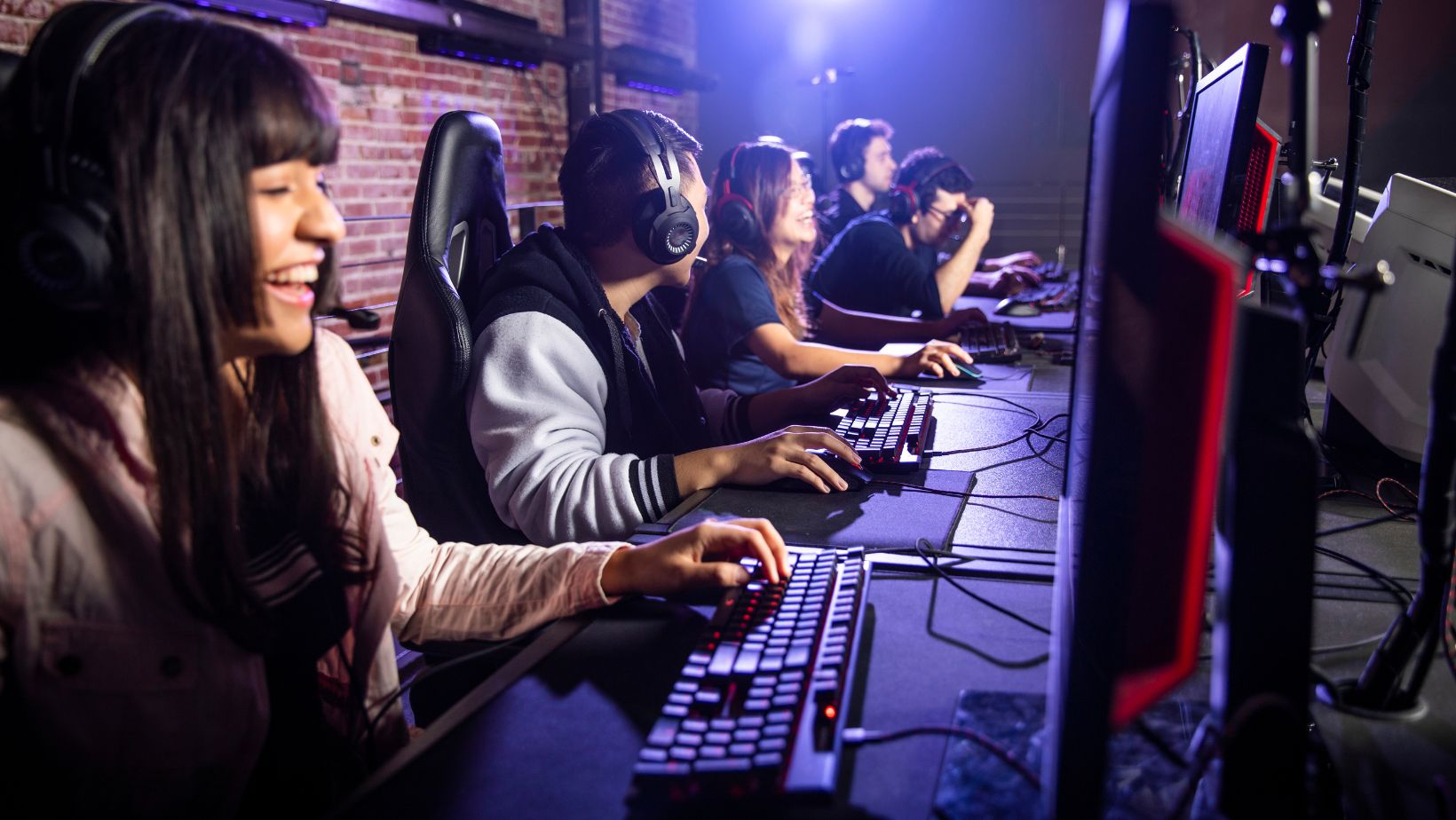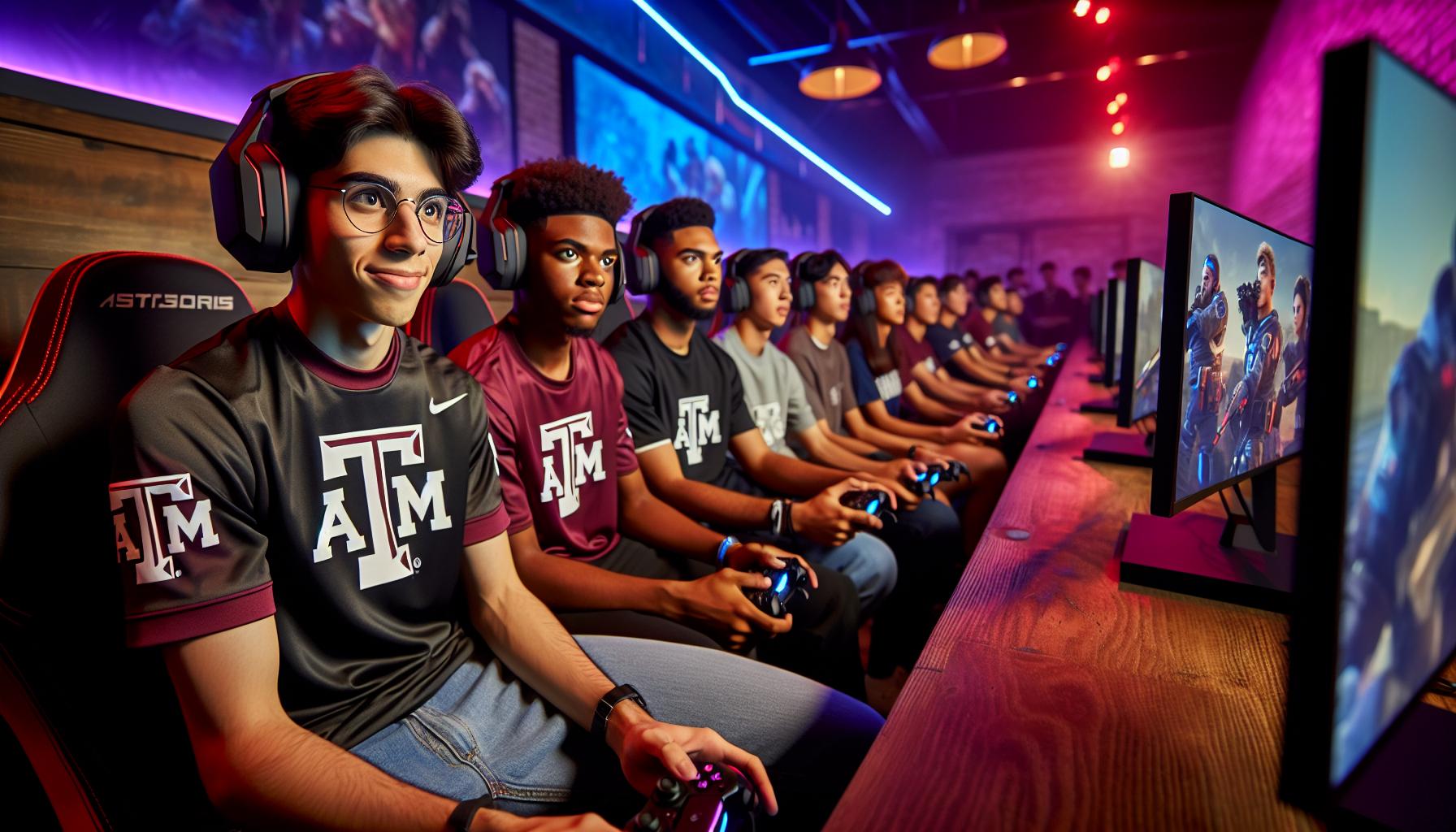As a passionate follower of collegiate esports, I’ve watched Texas A&M transform into a powerhouse in competitive gaming. The Aggies have built an impressive esports program that’s rapidly gaining recognition across North America’s collegiate scene.
Texas A&M’s commitment to esports goes beyond casual gaming. With dedicated practice facilities, professional coaching staff and competitive teams across multiple titles like League of Legends, Rocket League and Valorant, they’re creating opportunities for students to pursue their gaming passions at the highest level. I’ve seen firsthand how their program has grown from humble beginnings to becoming one of the most respected collegiate esports organizations in the country.
Key Takeaways
- Texas A&M’s esports program evolved from a student club (TAG) in 2013 to a full-fledged Division I program integrated with the Athletics Department by 2021
- The program features 5 varsity teams competing in major titles like League of Legends, Valorant, Rocket League, Overwatch, and Super Smash Bros, with 45 active student-athletes
- A state-of-the-art 3,400-square-foot Esports Arena houses 48 high-performance gaming stations, dedicated practice rooms, and professional broadcasting facilities
- Student-athletes receive comprehensive academic support, maintaining a minimum 2.5 GPA requirement, with access to tutoring, mentoring, and structured study sessions
- The program has achieved significant competitive success, including multiple regional championships and national tournament appearances across different game titles
Texas A&M Esports
Texas A&M’s esports program traces its roots to 2013 when students first organized competitive gaming events on campus. The program’s evolution reflects the broader growth of collegiate esports across North America.
From Student Club to Division I Program
 The Texas A&M Esports program started as TAG (Texas Aggie Gamers) in 2013. Here’s how the organization transformed:
The Texas A&M Esports program started as TAG (Texas Aggie Gamers) in 2013. Here’s how the organization transformed:
- Established competitive teams in League of Legends during Fall 2013
- Registered as an official student organization in 2014
- Partnered with the Department of Student Activities in 2016
- Launched varsity program status in 2019
- Secured dedicated practice facility in Memorial Student Center in 2020
- Integrated with Texas A&M Athletics Department in 2021
Notable Milestones and Achievements
The program’s competitive success includes significant achievements across multiple titles:
| Year | Achievement | Game/Event |
|---|---|---|
| 2017 | Top 8 | Collegiate StarLeague Finals |
| 2019 | Regional Champions | TESPA Overwatch League |
| 2020 | Conference Champions | Big 12 Esports League |
| 2021 | National Runner-up | College League of Legends |
| 2022 | First Place | Collegiate Rocket League Conference |
- Created scholarship opportunities for 25 student-athletes in 2020
- Established partnerships with gaming industry leaders like HyperX Discord
- Hosted 3 major collegiate tournaments with 1,000+ participants
- Developed broadcasting studio for live event coverage
- Implemented professional coaching staff across 5 competitive titles
Competitive Teams and Games
Texas A&M’s esports program features multiple competitive teams across diverse gaming titles, with varsity-level squads competing in national collegiate tournaments. Each team receives professional coaching support backed by advanced analytics tracking player performance metrics.
Varsity Esports Roster
Texas A&M fields 5 varsity esports teams with 45 active student-athletes. The roster includes:
- A-Team starters competing in primary tournaments
- B-Team players developing skills through secondary competitions
- Practice squad members training for roster advancement
- Dedicated team managers coordinating schedules logistics
- Student broadcasters handling match coverage streaming
Popular Game Titles and Divisions
The program competes in these major esports titles:
| Game Title | Division | Active Players | Notable Achievement |
|---|---|---|---|
| League of Legends | North Division | 12 | Conference Champions 2022 |
| Valorant | South Conference | 10 | Regional Finalist 2023 |
| Rocket League | Western Division | 9 | National Top 8 2023 |
| Overwatch | Central Region | 8 | Conference Semi-finalist 2023 |
| Super Smash Bros | Open Division | 6 | Individual Champion 2022 |
- Dedicated practice schedules 3-4 times weekly
- VOD review sessions with professional coaches
- Performance analytics tracking KPI metrics
- Structured scrimmage blocks against other universities
- Tournament travel support for championship events
Training Facilities and Resources![]()
Texas A&M’s esports program operates from state-of-the-art facilities equipped with professional-grade gaming equipment and support infrastructure. The program’s commitment to excellence reflects in its comprehensive training environment and experienced staff.
The Texas A&M Esports Arena
The 3,400-square-foot Texas A&M Esports Arena features 48 high-performance gaming stations equipped with RTX 3080 graphics cards, 360Hz monitors and ergonomic gaming chairs. The facility includes:
- 5 dedicated team practice rooms with soundproof walls
- Professional broadcasting studio with 4K streaming equipment
- Performance analysis lab with eye-tracking technology
- Player lounge area with review stations
- Equipment maintenance workshop
- Sports medicine recovery room
Professional Coaching Staff
The coaching infrastructure comprises 8 full-time professionals specializing in competitive gaming development:
- Head coach for each varsity title
- Strategic analysts for team compositions
- Mental performance coaches
- Athletic trainers specialized in esports
- Nutrition specialists focused on gaming performance
The coaching staff implements:
- Daily practice schedules with structured drills
- Weekly performance reviews using analytics software
- Monthly development plans for each player
- Cross-team coordination strategies
- Tournament preparation protocols
| Resource Type | Quantity | Specifications |
|---|---|---|
| Gaming PCs | 48 | RTX 3080, i9 Processors |
| Practice Rooms | 5 | 8-player capacity each |
| Analysis Stations | 6 | Dual monitor setups |
| Broadcast Equipment | 1 set | 4K capable, multi-cam |
| Performance Tracking | 3 systems | Stats, VOD, Biometrics |
Tournament Success and Championships
Texas A&M’s esports program has established a remarkable track record of competitive excellence across multiple titles. The program’s tournament achievements span regional qualifiers national championships showcasing consistent high-level performance.
Regional Competition Results
Texas A&M dominates regional collegiate esports competitions with 15 first-place finishes since 2019. The Rocket League team captured three consecutive South Conference Championships (2020-2022) while the League of Legends squad secured four straight Southwest Conference titles (2019-2022). Notable regional victories include:
- First place in TESPA South Region Overwatch (2019 2020)
- Champions of the SEC Valorant Invitational (2021 2022)
- Winners of the Texas Collegiate Series in multiple titles
- Three-time Big 12 Esports Challenge victors (2020-2022)
National Championship Appearances
The program’s national competition record demonstrates consistent top-tier performance across multiple games:
| Year | Game | Tournament | Placement |
|---|---|---|---|
| 2022 | Rocket League | CRL National Championship | 2nd Place |
| 2021 | League of Legends | College Championship | Top 4 |
| 2021 | Valorant | Collegiate Champions | Top 8 |
| 2020 | Overwatch | TESPA Collegiate Series | 3rd Place |
| 2019 | Super Smash Bros | College Nationals | Top 16 |
The program’s competitive teams qualified for 12 national championship events between 2019-2022 maintaining an 85% win rate in tournament bracket play. Tournament highlights include reaching semifinals in three major national championships hosting four regional qualifying events generating $75000 in prize pool earnings.
Student Life and Campus Integration
Texas A&M’s esports program integrates seamlessly into campus life through dedicated academic support systems and community-building initiatives. The program maintains a balance between competitive gaming excellence and student success through structured support mechanisms.
Academic Support for Student Athletes
At Texas A&M, esports athletes receive comprehensive academic assistance through specialized programs designed for student-athletes. The university provides dedicated tutoring services, study halls, academic advisors for course planning and personalized grade monitoring systems. Student-athletes maintain a minimum 2.5 GPA requirement to participate in competitive play while accessing priority registration for classes to accommodate practice schedules. The program’s academic success center offers:
- Academic mentoring sessions twice per week
- Access to subject-specific tutors
- Time management workshops
- Structured study periods between practice sessions
- Progress tracking through monthly performance reviews
Community Building Through Gaming
The esports program fosters campus-wide engagement through various community initiatives and events. The program organizes:
- Monthly open-house gaming sessions in the esports arena
- Intramural tournaments for non-varsity students
- Gaming-themed social events with 250+ attendees per semester
- Collaborative projects with other student organizations
- Mentorship programs connecting varsity players with casual gamers
- Charity streaming events raising $25,000+ annually
- Gaming workshops for local high school students
- Partnership programs with 15 campus departments
- Weekly viewing parties for major esports tournaments
- Student-led gaming development projects
| Community Engagement Metrics | Numbers |
|---|---|
| Active Student Members | 1,200+ |
| Annual Events | 35 |
| Student Organizations Partnerships | 25 |
| Weekly Arena Visitors | 500+ |
| Volunteer Hours Per Semester | 1,500 |
Future Growth and Development
Texas A&M’s esports program has outlined an ambitious roadmap for expansion through 2025. The program’s strategic plan focuses on facility enhancement, team development and recruitment optimization.
Planned Program Expansions
The Texas A&M Esports Arena expansion project includes adding 2,500 square feet of practice space by Fall 2024. Key developments include:
- Installing 24 additional gaming stations with RTX 4090 GPUs
- Creating 3 dedicated team rooms for match preparation
- Expanding the broadcasting studio with 4K production equipment
- Implementing a sports psychology center with 2 full-time mental performance coaches
- Establishing a content creation hub with 6 recording stations
- Launching an annual high school invitational tournament with 32 teams
- Offering 15 additional scholarship positions for incoming students
- Creating recruitment combines for 5 competitive titles
- Developing partnerships with 25 high school esports programs
- Implementing a scouting network covering 8 regional territories
- Establishing a summer training academy for prospective recruits
| Recruitment Targets | 2024 | 2025 |
|---|---|---|
| Scholarship Players | 40 | 55 |
| Practice Squad Members | 30 | 45 |
| Support Staff | 12 | 18 |
| Content Creators | 8 | 15 |
Texas A&M’s esports program stands as a shining example of what collegiate gaming can achieve. I’m impressed by how it’s grown from a student-led initiative to a powerhouse program with state-of-the-art facilities professional coaching and remarkable competitive success across multiple titles.
The program’s commitment to both athletic excellence and academic achievement sets a high standard for collegiate esports. With ambitious expansion plans and a strong foundation in place I’m confident Texas A&M will continue to lead the way in shaping the future of competitive gaming at the university level.
Looking at their track record and dedication to growth I believe Texas A&M Esports isn’t just participating in the collegiate gaming revolution – they’re defining it.

